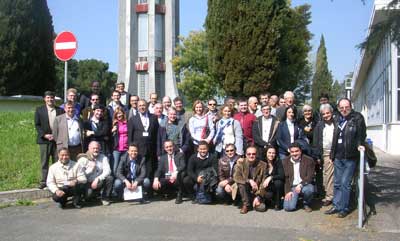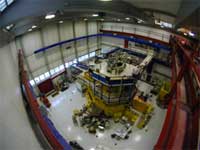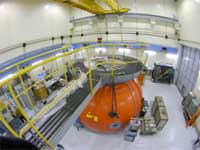Technical Visit
On Thursday 24 March RRFM participants where invited to a technical tour to ENEA Casaccia Research Center.
The Italian National Agency for the New Technologies, Energy and Sustainable Economic Development (ENEA), pursuant to an Italian law of July 2009, has a new mission and its activities are targeted to research, innovation technology and advanced services in the fields of energy - especially nuclear energy.

In the Casaccia Research Centre (C.R. Casaccia) near Rome, ENEA manages two nuclear Research Reactors that consequently plays an important role in the proclaimed Italian nuclear program:
Triga RC-1 (Reattore Casaccia 1) is the first research reactor that was built in the C.R. Casaccia. It is a common TRIGA Mark II reactor and it reached the first criticality in 1960. The first reactor core was realized with 61 standard TRIGA fuel elements, aluminium cladded and, in this condition, the reactor was operated until August 1965 at a steady state power level of 100 kW. In the summer of 1965, a program was established to increase the reactor power to 1 MW and after significant plant modifications (in order both to adapt the reactor to the new operative circumstances, including safety regulations, and to extend reactor flexibility in the widest research areas), the new criticality was reached in July 1967. The 1 MW reactor operative configuration was initially obtained with 76 standard TRIGA fuel elements stainless steel cladded. Triga RC-1 is pool thermal research reactor having a core contained in an aluminium vessel and placed inside of a cylindrical graphite reflector, bounded with lead shielding. The biological shield is provided by a concrete structure having an average thickness of 2.2 m. Demineralised water, filling the vessel, ensures the functions of neutron moderator, cooling mean and first biological shield. At the maximum power of 1 MW the highest neutron flux is available in the middle of the core through the central channel (2.68•1013 n/cm2/s). TRIGA RC-1 was also involved in the TRADE (TRiga Accelerator Driven Experiment) project in order to validate the ADS concept. A small homemade neutron tomography system is operating at the thermal column. A larger system is under construction, to be installed in correspondence of the tangential channel. The main activities that can be performed in the TRIGA RC-1 are: educational and training for university students and reactor operators; neutron radiography and tomography; irradiation and testing of instruments; radioisotopes production; support to the development of Gen. IV and ADS systems; neutron activation analysis.
TAPIRO (TAratura PIla Rapida a Potenza 0) is a fast neutron source reactor licensed in 1971 for a maximum power of 5 kW. The project, entirely developed by ENEA's staff, is based on the general concept of AFSR (Argonne Fast Source Reactor - Idaho Falls). The reactor has a homogeneous HEU Mo-U cylindrical core with about 6 cm of radius and 11 cm of height with a cylindrical copper reflector (30 cm thickness) and a spherical borated concrete shielding (170 cm thickness). Channels of various dimensions and with different neutron spectra are distributed around the core. A large thermal column (2 m3) can host experimental assemblies for any research purpose. The core is cooled by mean of helium circulating at a power greater than 50 W. At the maximum power of 5 kW the highest flux of 4.0•1012 n/cm2/s (8.0•1011 n/cm2/s with E>1.35 MeV) is available in the middle of the core through the diametral channel. The BNCT had been the main activity for several years but, owing to problems on funding and authorizations for patient therapy, this activity was closed. After the dismantling of the BNCT facility and the additional radiological shielding, the TAPIRO reactor is ready to be used for: validation of Monte Carlo model of the reactor; qualification of integrated circuit and discrete semiconductors in a fast neutron environment for aerospace applications; benchmark experiments to support the development of Gen IV reactors; educational and training.

Fig.1 TRIGA RC-1
|

Fig. 2 TAPIRO
|
Schedule
8.00 |
pick-up at Conference hotel; |
9.00 - 12.00 |
Technical visit |
12.00-13.00 |
Lunch |
13.30 |
Departure from Casaccia |
14.30 |
Drop-off at hotel |
Registration
The technical tour is included in the registration fee.
The maximum size of each group is limited and participation is on a first-come, first-served basis.
Please fill in the appropriate section of the registration form and the required information for the security check.